
Eskom has asked for a 16% increase in electricity prices each year for the next five years, the parastatal said on Monday.
“We seek to ensure that Eskom can cover the costs of supplying the electricity needed to power SA and invest in the future,” CEO Brian Dames said in Johannesburg.
This would more than double the price of electricity from 61c/kWh in 2012/13 to 128c/kWh in 2017/18.
The 16% increase was broken down into a 13% increase for Eskom’s own needs and 3% for the introduction of independent power producers.
Eskom said electricity had been charged at below reflective costs and this was not sustainable.
“Our application balances SA’s needs for a secure supply of power and for a sustainable electricity industry, with our recognition of the impact which tariff increases have on the economy, particularly on the poor,” Dames said.
Eskom submitted its application for the increases to the National Energy Regulator of SA (Nersa) on Friday.
The current Multi-Year Price Determination, MYPD2, ends on 31 March 2013.
Nersa will announce its final decision in February, following an extended period of consultation and public hearings.
“This is the start of a process. This is not a decision. A decision will be made by the regulator,” Dames said.
He said the application proposed a price path that migrated electricity prices towards a level where they covered the full cost of producing electricity. This would include operating costs such as coal, maintenance and employees, and the cost of servicing the debt raised to finance Eskom’s new build programme.
Eskom’s application proposed a tariff structure which would cross-subsidise poor households which used little electricity. In terms of this, these households would get single-digit price increases.
Dames said the parastatal would apply to Nersa this week to review a special pricing agreement it was tied into with BHP Billiton for its aluminium smelters in KwaZulu-Natal.
“The special pricing agreements link the price the smelters pay for electricity to the dollar price of aluminium and were entered into in the 1990s when Eskom had surplus generating capacity, which is no longer the case.” — Sapa




